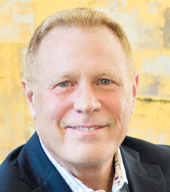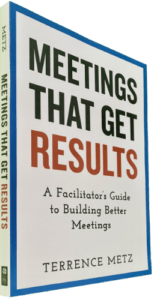Today we bring you twelve significant behaviors that define successful, professional facilitators. (i.e., GREAT Facilitators) Our scope focuses on structured facilitation (NOT Kum-Bah-Yah). Structured facilitation requires a balanced blend of leadership, facilitation, and methodology. (An alpha sort sequences the following, not order of importance).
The first three behaviors:
- 7:59 AM preparation and interviews (i.e., managing expectations and ownership). Increased experience forces top-notch facilitators to value preparation more than ever. No class, certification, or silver bullets help facilitators who show up without preparation.
- Active listening (i.e., seeking to understand rather than being understood). Of facilitation’s core skills, active listening remains the easiest to understand and the hardest to do.
- Annotated agenda (i.e., visualizing everything the session leader does or asks in advance). Preparation or writing down what you intend to say and do remains critical. Therefore, Great facilitators don’t rely on memory, they write it down.
The next three behaviors:
- Common nouns and purpose give rise to natural categories . A professional NEVER asks a group HOW they would like to ‘categorize a list.’ Common nouns are symptomatic of the likelihood of clusters. Normally categorizes arise from shared or common purpose.
- Holarchy (i.e., interdependent reciprocities—contextual explanation of how it all fits together). When active listening fails to resolve conflict, appeal to the organizational objectives. They drive the determination of whose argument should prevail. Begin with the project, then the program, then the business unit, and if necessary, enterprise objectives. The holarchy provides the key to alignment and a professional knows how to apply it.
- “I” no longer (i.e., the substitution of pluralistic and integrative rhetoric for the first person singular). Professionals avoid reference to themselves alone. Everything ‘we’ do is for the benefit of them and you, not ‘me.’ The least professional words a facilitator could utter — “Help me.”
Three more behaviors:
- Life Cycle: Plan ☛ Acquire ☛ Operate ☛ Control (i.e., great tool and inherent rationale behind all life cycle methodologies). It matters not whether building requirements or an action plan. Blue-chip facilitators explore at least four activities (likely more). They ensure at minimum one activity within each of the four primary life-cycle stages.
- Numeric SWOT leads to consensual actions (i.e., Easily the best way to prioritize hundreds of items and build consensus around “WHAT” needs to be done to support the purpose). So many untrained facilitators build four lists, hang them on the wall, and ask “Now what?” Traditional SWOT remains an awful method for galvanizing consensus. Outstanding facilitators consider the MGRUSH quantitative approach instead.
- Right-to-left thinking or, focus on the deliverable first (i.e., starting with the end in mind—forcing the abstract into the concrete). Leadership demands understanding what ‘DONE’ looks like. Top-flight professionals constantly apply a ‘DONE’ consciousness against the meeting deliverable, agenda step, supporting activity, and even specific questions. Always start with the end in mind.
The final three behaviors:
- “The Purpose is to . . . So That . . . “ (i.e., an amazing tool to extract the “strategy” behind something too small for a “strategic plan”). The professional facilitators’ ‘screwdriver.’ is known simply as the Purpose Tool. Use it repeatedly to first build consensus around WHY something exists before discussing WHAT can be done to make it better.
- Trivium (i.e., the natural force behind the structure of movement and progress). Plato called it Logic, Rhetoric, and Grammar. Our sixth-grade teachers called it WHY, WHAT, and HOW. Project life cycles are called Planning, Analysis, and Design. We call it Will, Wisdom, and Activity. The Trivium represents the nature of structured facilitation as superb facilitators help groups transform from the abstract to the concrete.
- Website resources (i.e.,” You get to ride all the rides, as many times as you want.”). You will find many of the finest facilitators in the world among the thousands of MGRUSH alumni. Therefore, use online access to agendas, templates, and other meeting support tools to make your life easier.
______
Don’t ruin your career by hosting bad meetings. Sign up for a workshop or send this to someone who should. MGRUSH workshops focus on meeting design and practice. Each person practices tools, methods, and activities daily during the week. Therefore, while some call this immersion, we call it the road to building high-value facilitation skills.
Our workshops also provide a superb way to earn up to 40 SEUs from the Scrum Alliance, 40 CDUs from IIBA, 40 Continuous Learning Points (CLPs) based on Federal Acquisition Certification Continuous Professional Learning Requirements using Training and Education activities, 40 Professional Development Units (PDUs) from SAVE International, as well as 4.0 CEUs for other professions. (See workshop and Reference Manual descriptions for details.)
Want a free 10-minute break timer? Sign up for our once-monthly newsletter HERE and receive a free timer along with four other of our favorite facilitation tools.

Terrence Metz, president of MG RUSH Facilitation Training, was just 22-years-old and working as a Sales Engineer at Honeywell when he recognized a widespread problem—most meetings were ineffective and poorly led, wasting both time and company resources. However, he also observed meetings that worked. What set them apart? A well-prepared leader who structured the session to ensure participants contributed meaningfully and achieved clear outcomes.
Throughout his career, Metz, who earned an MBA from Kellogg (Northwestern University) experienced and also trained in various facilitation techniques. In 2004, he purchased MG RUSH where he shifted his focus toward improving established meeting designs and building a curriculum that would teach others how to lead, facilitate, and structure meetings that drive results. His expertise in training world-class facilitators led to the 2020 publication of Meetings That Get Results: A Guide to Building Better Meetings, a comprehensive resource on effectively building consensus.
Grounded in the principle that “nobody is smarter than everybody,” the book details the why, what, and how of building consensus when making decisions, planning, and solving problems. Along with a Participant’s Guide and supplemental workshops, it supports learning from foundational awareness to professional certification.
Metz’s first book, Change or Die: A Business Process Improvement Manual, tackled the challenges of process optimization. His upcoming book, Catalyst: Facilitating Innovation, focuses on meetings and workshops that don’t simply end when time runs out but conclude with actionable next steps and clear assignments—ensuring progress beyond discussions and ideas.




